Operations Management: Leadership and Management Perspectives
VerifiedAdded on 2024/04/26
|16
|4518
|494
Report
AI Summary
This report provides an analysis of leadership and management within operations management, using Sainsbury's PLC as a case study. It defines leaders and managers, compares their roles, and applies situational and contingency leadership models. The report also examines key approaches to operations management, the role of leaders and managers in Amazon's operations management, and the importance of operations management in achieving Amazon's business objectives. Managerial theories such as Scientific Management Theory and Elton Mayo’s theory have been considered to explain the subject.
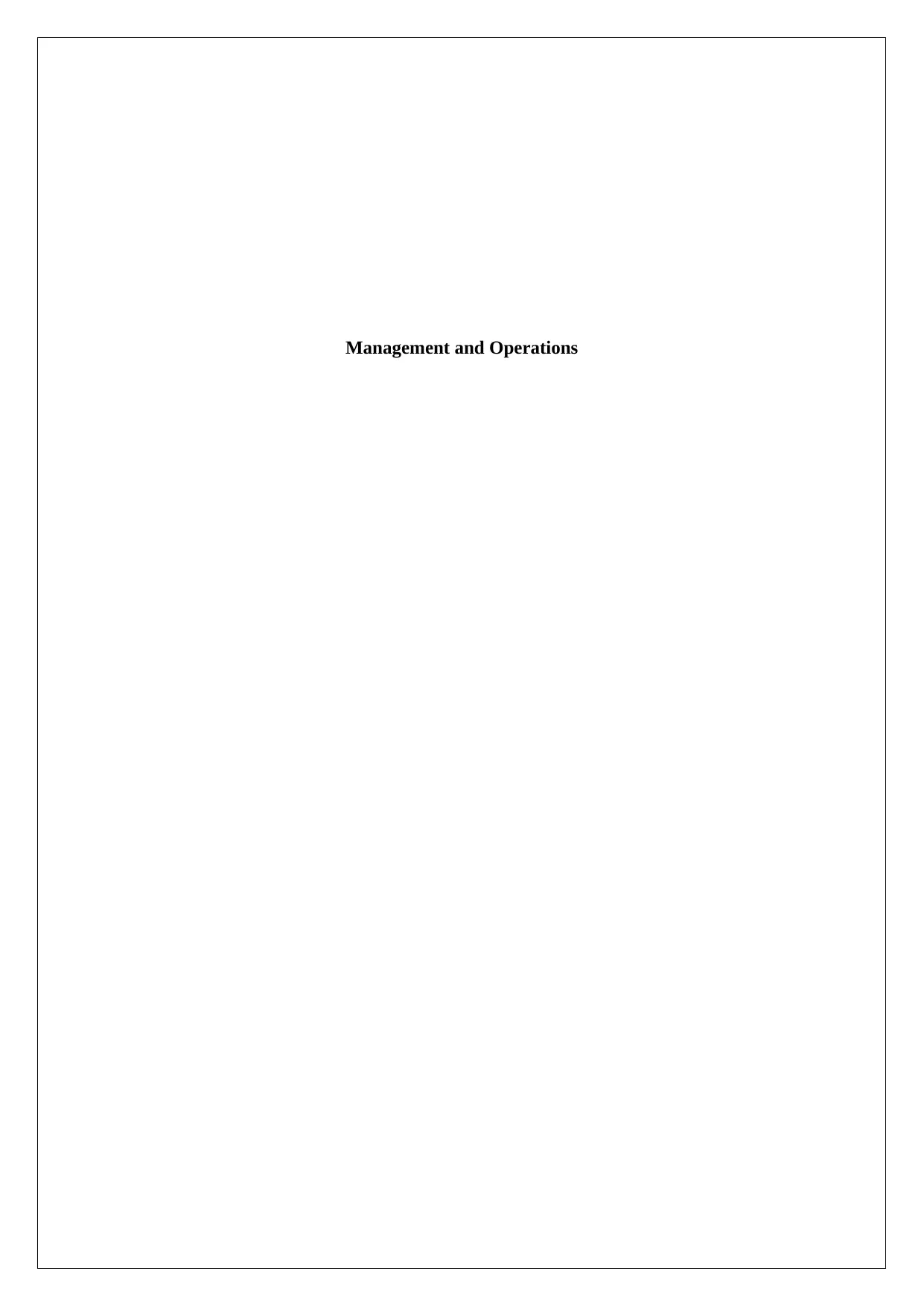
Management and Operations
Paraphrase This Document
Need a fresh take? Get an instant paraphrase of this document with our AI Paraphraser
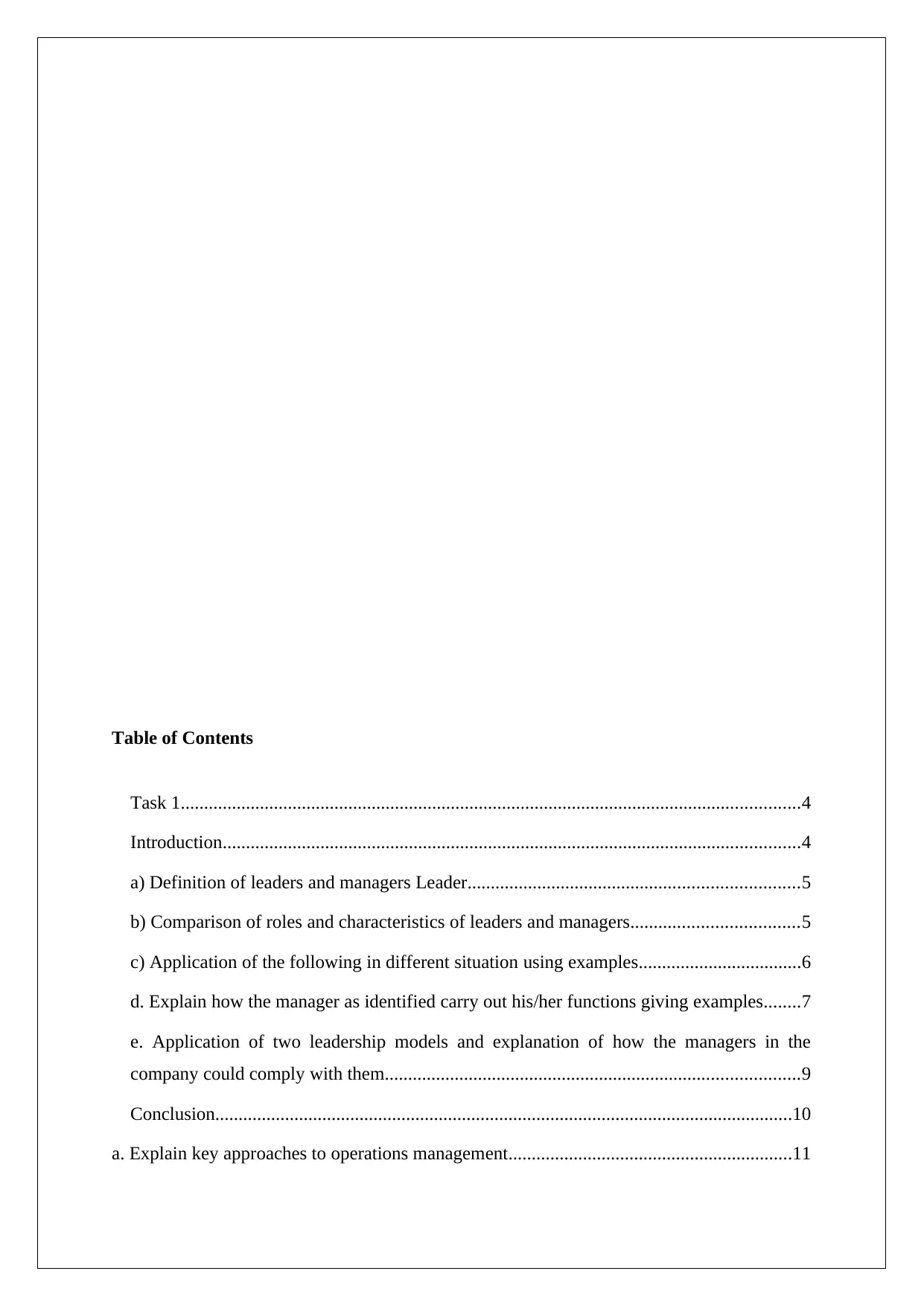
Table of Contents
Task 1.....................................................................................................................................4
Introduction............................................................................................................................4
a) Definition of leaders and managers Leader.......................................................................5
b) Comparison of roles and characteristics of leaders and managers....................................5
c) Application of the following in different situation using examples...................................6
d. Explain how the manager as identified carry out his/her functions giving examples........7
e. Application of two leadership models and explanation of how the managers in the
company could comply with them.........................................................................................9
Conclusion............................................................................................................................10
a. Explain key approaches to operations management.............................................................11
Task 1.....................................................................................................................................4
Introduction............................................................................................................................4
a) Definition of leaders and managers Leader.......................................................................5
b) Comparison of roles and characteristics of leaders and managers....................................5
c) Application of the following in different situation using examples...................................6
d. Explain how the manager as identified carry out his/her functions giving examples........7
e. Application of two leadership models and explanation of how the managers in the
company could comply with them.........................................................................................9
Conclusion............................................................................................................................10
a. Explain key approaches to operations management.............................................................11
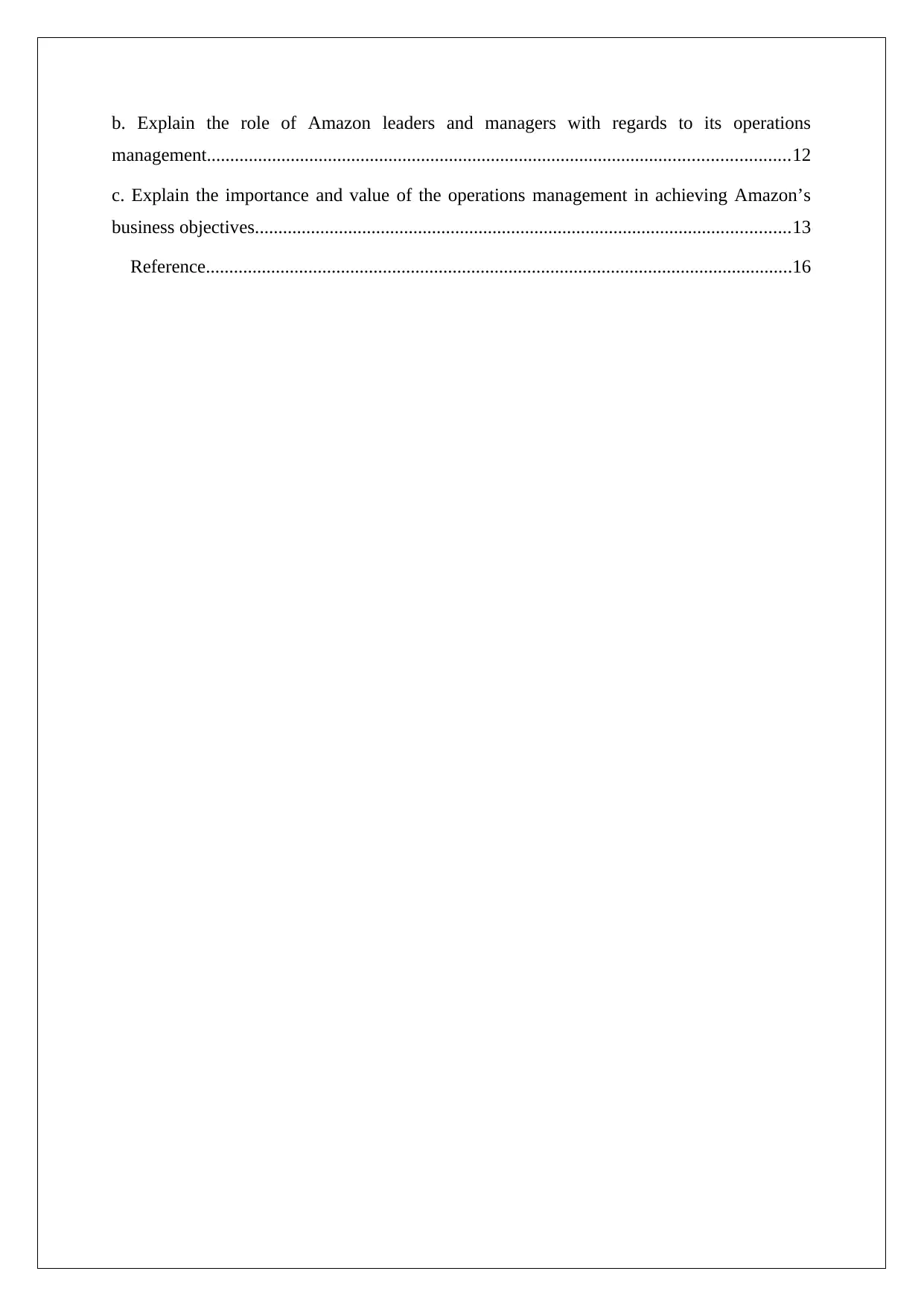
b. Explain the role of Amazon leaders and managers with regards to its operations
management.............................................................................................................................12
c. Explain the importance and value of the operations management in achieving Amazon’s
business objectives...................................................................................................................13
Reference..............................................................................................................................16
management.............................................................................................................................12
c. Explain the importance and value of the operations management in achieving Amazon’s
business objectives...................................................................................................................13
Reference..............................................................................................................................16
⊘ This is a preview!⊘
Do you want full access?
Subscribe today to unlock all pages.

Trusted by 1+ million students worldwide
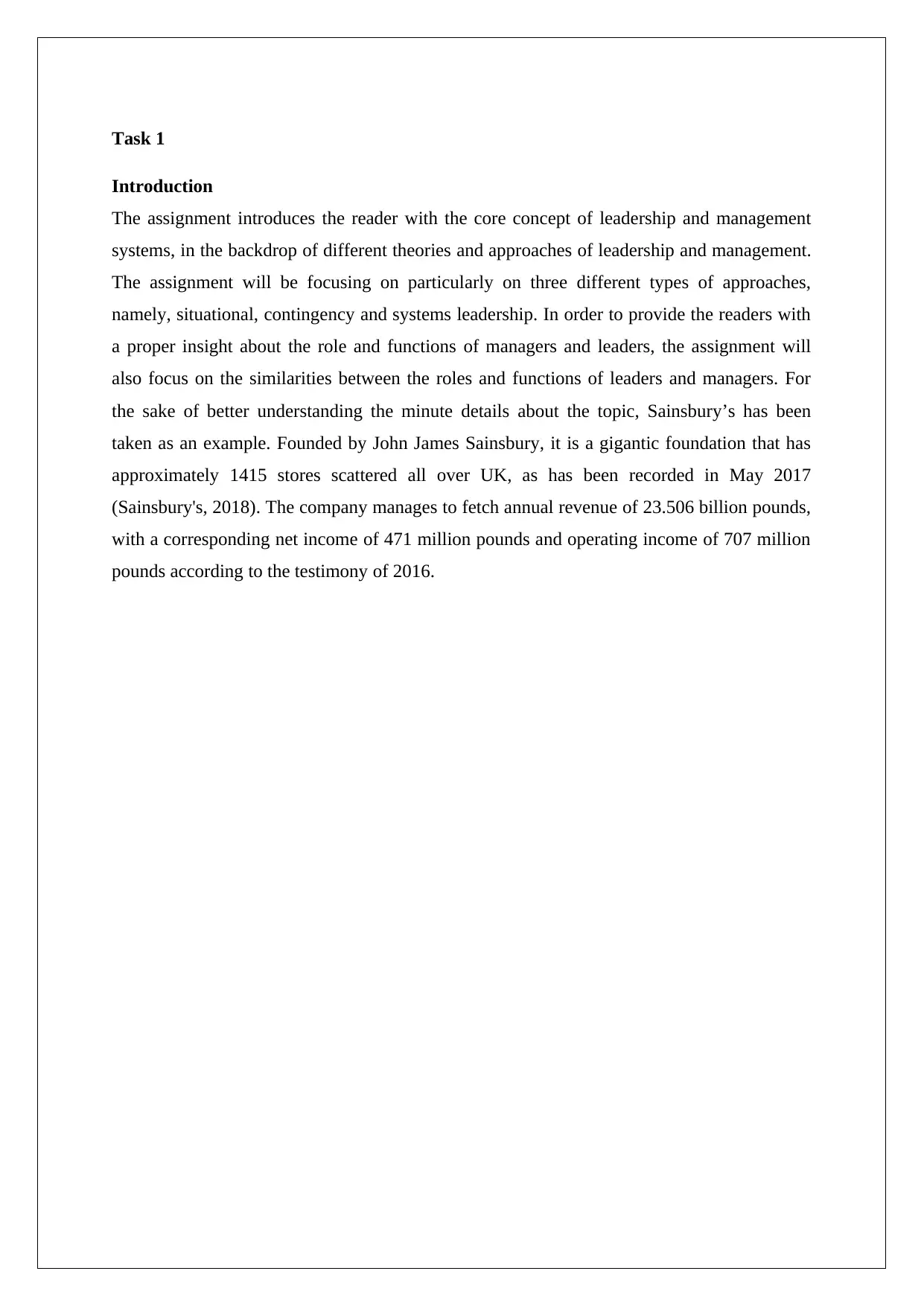
Task 1
Introduction
The assignment introduces the reader with the core concept of leadership and management
systems, in the backdrop of different theories and approaches of leadership and management.
The assignment will be focusing on particularly on three different types of approaches,
namely, situational, contingency and systems leadership. In order to provide the readers with
a proper insight about the role and functions of managers and leaders, the assignment will
also focus on the similarities between the roles and functions of leaders and managers. For
the sake of better understanding the minute details about the topic, Sainsbury’s has been
taken as an example. Founded by John James Sainsbury, it is a gigantic foundation that has
approximately 1415 stores scattered all over UK, as has been recorded in May 2017
(Sainsbury's, 2018). The company manages to fetch annual revenue of 23.506 billion pounds,
with a corresponding net income of 471 million pounds and operating income of 707 million
pounds according to the testimony of 2016.
Introduction
The assignment introduces the reader with the core concept of leadership and management
systems, in the backdrop of different theories and approaches of leadership and management.
The assignment will be focusing on particularly on three different types of approaches,
namely, situational, contingency and systems leadership. In order to provide the readers with
a proper insight about the role and functions of managers and leaders, the assignment will
also focus on the similarities between the roles and functions of leaders and managers. For
the sake of better understanding the minute details about the topic, Sainsbury’s has been
taken as an example. Founded by John James Sainsbury, it is a gigantic foundation that has
approximately 1415 stores scattered all over UK, as has been recorded in May 2017
(Sainsbury's, 2018). The company manages to fetch annual revenue of 23.506 billion pounds,
with a corresponding net income of 471 million pounds and operating income of 707 million
pounds according to the testimony of 2016.
Paraphrase This Document
Need a fresh take? Get an instant paraphrase of this document with our AI Paraphraser
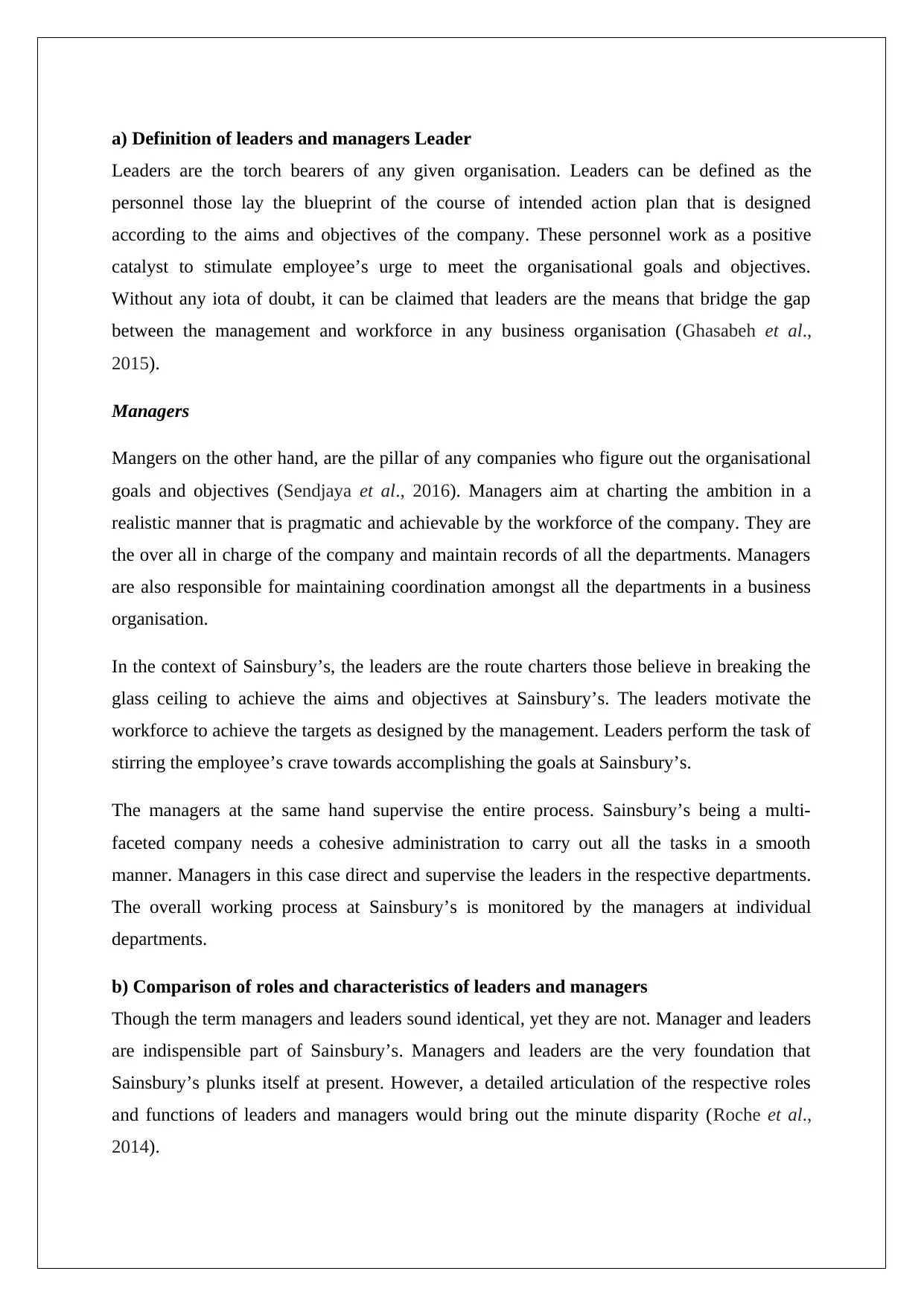
a) Definition of leaders and managers Leader
Leaders are the torch bearers of any given organisation. Leaders can be defined as the
personnel those lay the blueprint of the course of intended action plan that is designed
according to the aims and objectives of the company. These personnel work as a positive
catalyst to stimulate employee’s urge to meet the organisational goals and objectives.
Without any iota of doubt, it can be claimed that leaders are the means that bridge the gap
between the management and workforce in any business organisation (Ghasabeh et al.,
2015).
Managers
Mangers on the other hand, are the pillar of any companies who figure out the organisational
goals and objectives (Sendjaya et al., 2016). Managers aim at charting the ambition in a
realistic manner that is pragmatic and achievable by the workforce of the company. They are
the over all in charge of the company and maintain records of all the departments. Managers
are also responsible for maintaining coordination amongst all the departments in a business
organisation.
In the context of Sainsbury’s, the leaders are the route charters those believe in breaking the
glass ceiling to achieve the aims and objectives at Sainsbury’s. The leaders motivate the
workforce to achieve the targets as designed by the management. Leaders perform the task of
stirring the employee’s crave towards accomplishing the goals at Sainsbury’s.
The managers at the same hand supervise the entire process. Sainsbury’s being a multi-
faceted company needs a cohesive administration to carry out all the tasks in a smooth
manner. Managers in this case direct and supervise the leaders in the respective departments.
The overall working process at Sainsbury’s is monitored by the managers at individual
departments.
b) Comparison of roles and characteristics of leaders and managers
Though the term managers and leaders sound identical, yet they are not. Manager and leaders
are indispensible part of Sainsbury’s. Managers and leaders are the very foundation that
Sainsbury’s plunks itself at present. However, a detailed articulation of the respective roles
and functions of leaders and managers would bring out the minute disparity (Roche et al.,
2014).
Leaders are the torch bearers of any given organisation. Leaders can be defined as the
personnel those lay the blueprint of the course of intended action plan that is designed
according to the aims and objectives of the company. These personnel work as a positive
catalyst to stimulate employee’s urge to meet the organisational goals and objectives.
Without any iota of doubt, it can be claimed that leaders are the means that bridge the gap
between the management and workforce in any business organisation (Ghasabeh et al.,
2015).
Managers
Mangers on the other hand, are the pillar of any companies who figure out the organisational
goals and objectives (Sendjaya et al., 2016). Managers aim at charting the ambition in a
realistic manner that is pragmatic and achievable by the workforce of the company. They are
the over all in charge of the company and maintain records of all the departments. Managers
are also responsible for maintaining coordination amongst all the departments in a business
organisation.
In the context of Sainsbury’s, the leaders are the route charters those believe in breaking the
glass ceiling to achieve the aims and objectives at Sainsbury’s. The leaders motivate the
workforce to achieve the targets as designed by the management. Leaders perform the task of
stirring the employee’s crave towards accomplishing the goals at Sainsbury’s.
The managers at the same hand supervise the entire process. Sainsbury’s being a multi-
faceted company needs a cohesive administration to carry out all the tasks in a smooth
manner. Managers in this case direct and supervise the leaders in the respective departments.
The overall working process at Sainsbury’s is monitored by the managers at individual
departments.
b) Comparison of roles and characteristics of leaders and managers
Though the term managers and leaders sound identical, yet they are not. Manager and leaders
are indispensible part of Sainsbury’s. Managers and leaders are the very foundation that
Sainsbury’s plunks itself at present. However, a detailed articulation of the respective roles
and functions of leaders and managers would bring out the minute disparity (Roche et al.,
2014).
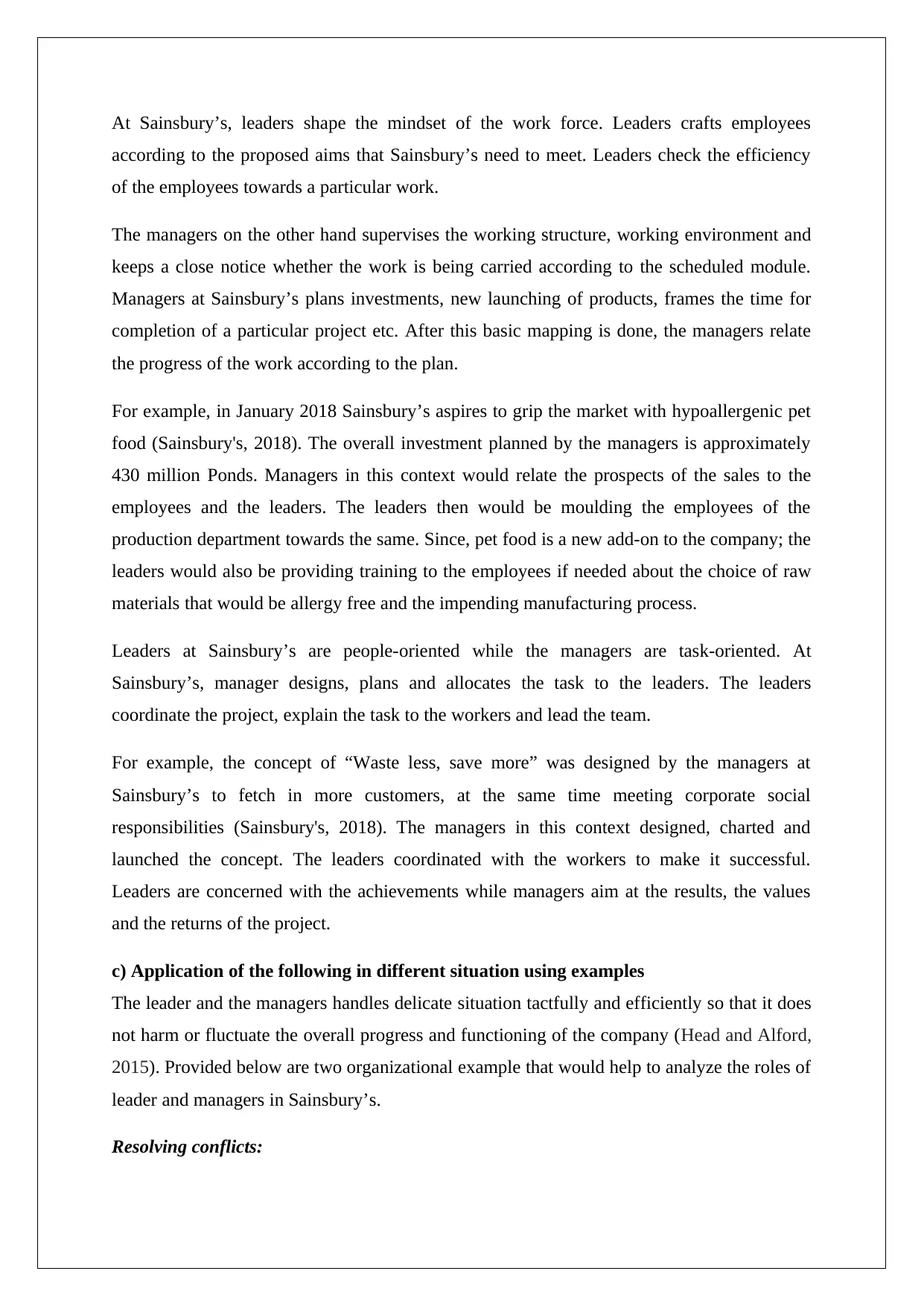
At Sainsbury’s, leaders shape the mindset of the work force. Leaders crafts employees
according to the proposed aims that Sainsbury’s need to meet. Leaders check the efficiency
of the employees towards a particular work.
The managers on the other hand supervises the working structure, working environment and
keeps a close notice whether the work is being carried according to the scheduled module.
Managers at Sainsbury’s plans investments, new launching of products, frames the time for
completion of a particular project etc. After this basic mapping is done, the managers relate
the progress of the work according to the plan.
For example, in January 2018 Sainsbury’s aspires to grip the market with hypoallergenic pet
food (Sainsbury's, 2018). The overall investment planned by the managers is approximately
430 million Ponds. Managers in this context would relate the prospects of the sales to the
employees and the leaders. The leaders then would be moulding the employees of the
production department towards the same. Since, pet food is a new add-on to the company; the
leaders would also be providing training to the employees if needed about the choice of raw
materials that would be allergy free and the impending manufacturing process.
Leaders at Sainsbury’s are people-oriented while the managers are task-oriented. At
Sainsbury’s, manager designs, plans and allocates the task to the leaders. The leaders
coordinate the project, explain the task to the workers and lead the team.
For example, the concept of “Waste less, save more” was designed by the managers at
Sainsbury’s to fetch in more customers, at the same time meeting corporate social
responsibilities (Sainsbury's, 2018). The managers in this context designed, charted and
launched the concept. The leaders coordinated with the workers to make it successful.
Leaders are concerned with the achievements while managers aim at the results, the values
and the returns of the project.
c) Application of the following in different situation using examples
The leader and the managers handles delicate situation tactfully and efficiently so that it does
not harm or fluctuate the overall progress and functioning of the company (Head and Alford,
2015). Provided below are two organizational example that would help to analyze the roles of
leader and managers in Sainsbury’s.
Resolving conflicts:
according to the proposed aims that Sainsbury’s need to meet. Leaders check the efficiency
of the employees towards a particular work.
The managers on the other hand supervises the working structure, working environment and
keeps a close notice whether the work is being carried according to the scheduled module.
Managers at Sainsbury’s plans investments, new launching of products, frames the time for
completion of a particular project etc. After this basic mapping is done, the managers relate
the progress of the work according to the plan.
For example, in January 2018 Sainsbury’s aspires to grip the market with hypoallergenic pet
food (Sainsbury's, 2018). The overall investment planned by the managers is approximately
430 million Ponds. Managers in this context would relate the prospects of the sales to the
employees and the leaders. The leaders then would be moulding the employees of the
production department towards the same. Since, pet food is a new add-on to the company; the
leaders would also be providing training to the employees if needed about the choice of raw
materials that would be allergy free and the impending manufacturing process.
Leaders at Sainsbury’s are people-oriented while the managers are task-oriented. At
Sainsbury’s, manager designs, plans and allocates the task to the leaders. The leaders
coordinate the project, explain the task to the workers and lead the team.
For example, the concept of “Waste less, save more” was designed by the managers at
Sainsbury’s to fetch in more customers, at the same time meeting corporate social
responsibilities (Sainsbury's, 2018). The managers in this context designed, charted and
launched the concept. The leaders coordinated with the workers to make it successful.
Leaders are concerned with the achievements while managers aim at the results, the values
and the returns of the project.
c) Application of the following in different situation using examples
The leader and the managers handles delicate situation tactfully and efficiently so that it does
not harm or fluctuate the overall progress and functioning of the company (Head and Alford,
2015). Provided below are two organizational example that would help to analyze the roles of
leader and managers in Sainsbury’s.
Resolving conflicts:
⊘ This is a preview!⊘
Do you want full access?
Subscribe today to unlock all pages.

Trusted by 1+ million students worldwide
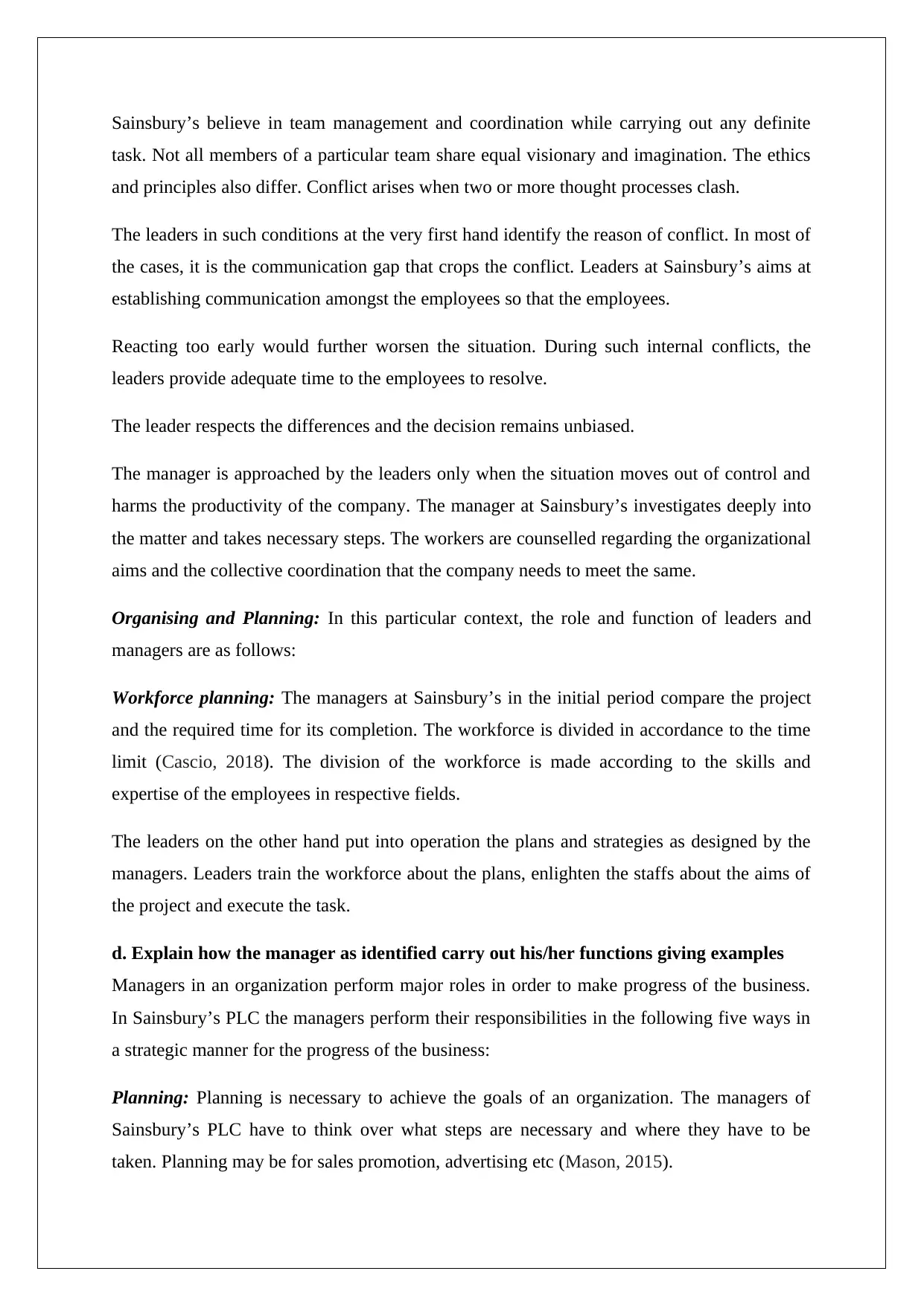
Sainsbury’s believe in team management and coordination while carrying out any definite
task. Not all members of a particular team share equal visionary and imagination. The ethics
and principles also differ. Conflict arises when two or more thought processes clash.
The leaders in such conditions at the very first hand identify the reason of conflict. In most of
the cases, it is the communication gap that crops the conflict. Leaders at Sainsbury’s aims at
establishing communication amongst the employees so that the employees.
Reacting too early would further worsen the situation. During such internal conflicts, the
leaders provide adequate time to the employees to resolve.
The leader respects the differences and the decision remains unbiased.
The manager is approached by the leaders only when the situation moves out of control and
harms the productivity of the company. The manager at Sainsbury’s investigates deeply into
the matter and takes necessary steps. The workers are counselled regarding the organizational
aims and the collective coordination that the company needs to meet the same.
Organising and Planning: In this particular context, the role and function of leaders and
managers are as follows:
Workforce planning: The managers at Sainsbury’s in the initial period compare the project
and the required time for its completion. The workforce is divided in accordance to the time
limit (Cascio, 2018). The division of the workforce is made according to the skills and
expertise of the employees in respective fields.
The leaders on the other hand put into operation the plans and strategies as designed by the
managers. Leaders train the workforce about the plans, enlighten the staffs about the aims of
the project and execute the task.
d. Explain how the manager as identified carry out his/her functions giving examples
Managers in an organization perform major roles in order to make progress of the business.
In Sainsbury’s PLC the managers perform their responsibilities in the following five ways in
a strategic manner for the progress of the business:
Planning: Planning is necessary to achieve the goals of an organization. The managers of
Sainsbury’s PLC have to think over what steps are necessary and where they have to be
taken. Planning may be for sales promotion, advertising etc (Mason, 2015).
task. Not all members of a particular team share equal visionary and imagination. The ethics
and principles also differ. Conflict arises when two or more thought processes clash.
The leaders in such conditions at the very first hand identify the reason of conflict. In most of
the cases, it is the communication gap that crops the conflict. Leaders at Sainsbury’s aims at
establishing communication amongst the employees so that the employees.
Reacting too early would further worsen the situation. During such internal conflicts, the
leaders provide adequate time to the employees to resolve.
The leader respects the differences and the decision remains unbiased.
The manager is approached by the leaders only when the situation moves out of control and
harms the productivity of the company. The manager at Sainsbury’s investigates deeply into
the matter and takes necessary steps. The workers are counselled regarding the organizational
aims and the collective coordination that the company needs to meet the same.
Organising and Planning: In this particular context, the role and function of leaders and
managers are as follows:
Workforce planning: The managers at Sainsbury’s in the initial period compare the project
and the required time for its completion. The workforce is divided in accordance to the time
limit (Cascio, 2018). The division of the workforce is made according to the skills and
expertise of the employees in respective fields.
The leaders on the other hand put into operation the plans and strategies as designed by the
managers. Leaders train the workforce about the plans, enlighten the staffs about the aims of
the project and execute the task.
d. Explain how the manager as identified carry out his/her functions giving examples
Managers in an organization perform major roles in order to make progress of the business.
In Sainsbury’s PLC the managers perform their responsibilities in the following five ways in
a strategic manner for the progress of the business:
Planning: Planning is necessary to achieve the goals of an organization. The managers of
Sainsbury’s PLC have to think over what steps are necessary and where they have to be
taken. Planning may be for sales promotion, advertising etc (Mason, 2015).
Paraphrase This Document
Need a fresh take? Get an instant paraphrase of this document with our AI Paraphraser
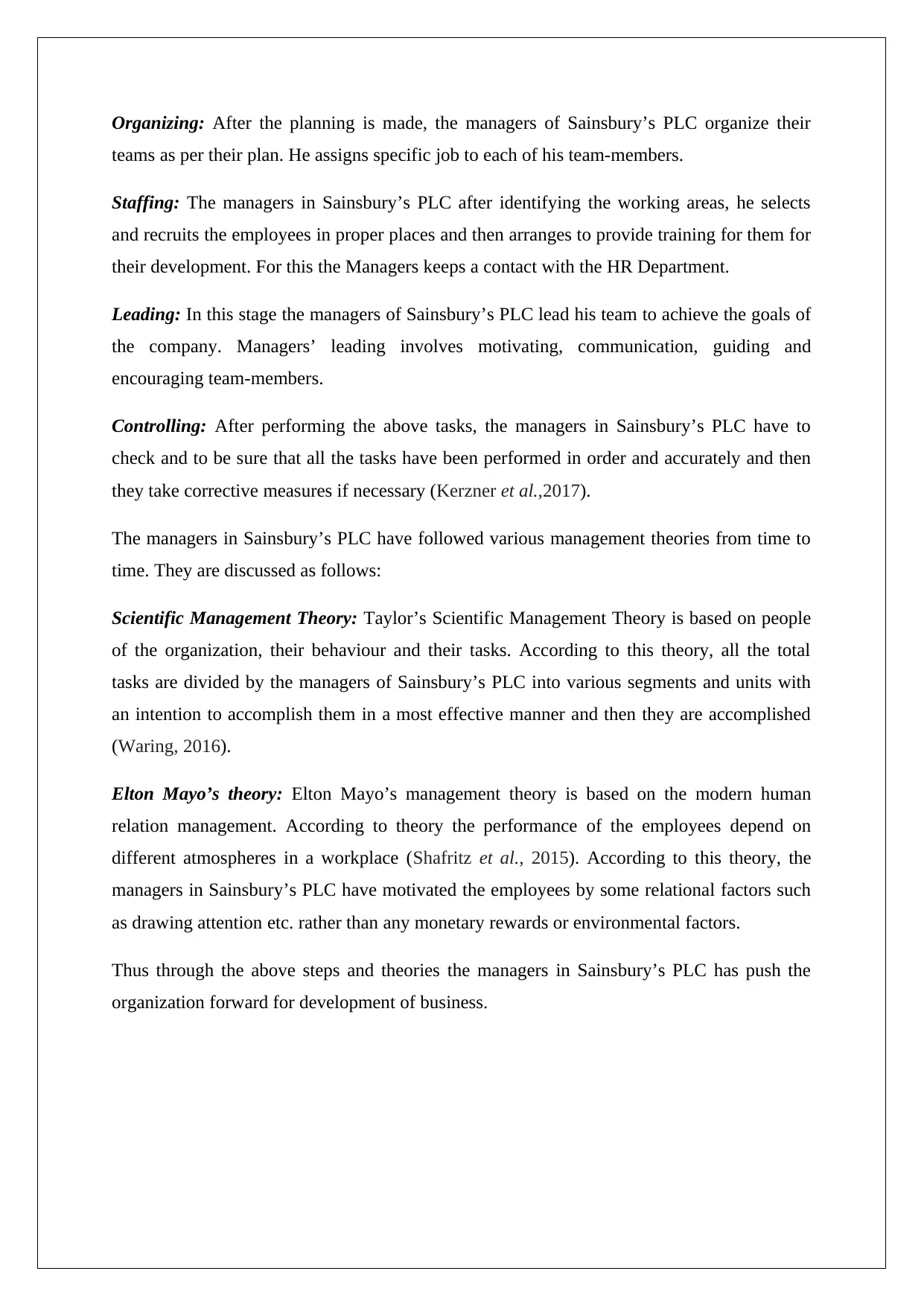
Organizing: After the planning is made, the managers of Sainsbury’s PLC organize their
teams as per their plan. He assigns specific job to each of his team-members.
Staffing: The managers in Sainsbury’s PLC after identifying the working areas, he selects
and recruits the employees in proper places and then arranges to provide training for them for
their development. For this the Managers keeps a contact with the HR Department.
Leading: In this stage the managers of Sainsbury’s PLC lead his team to achieve the goals of
the company. Managers’ leading involves motivating, communication, guiding and
encouraging team-members.
Controlling: After performing the above tasks, the managers in Sainsbury’s PLC have to
check and to be sure that all the tasks have been performed in order and accurately and then
they take corrective measures if necessary (Kerzner et al.,2017).
The managers in Sainsbury’s PLC have followed various management theories from time to
time. They are discussed as follows:
Scientific Management Theory: Taylor’s Scientific Management Theory is based on people
of the organization, their behaviour and their tasks. According to this theory, all the total
tasks are divided by the managers of Sainsbury’s PLC into various segments and units with
an intention to accomplish them in a most effective manner and then they are accomplished
(Waring, 2016).
Elton Mayo’s theory: Elton Mayo’s management theory is based on the modern human
relation management. According to theory the performance of the employees depend on
different atmospheres in a workplace (Shafritz et al., 2015). According to this theory, the
managers in Sainsbury’s PLC have motivated the employees by some relational factors such
as drawing attention etc. rather than any monetary rewards or environmental factors.
Thus through the above steps and theories the managers in Sainsbury’s PLC has push the
organization forward for development of business.
teams as per their plan. He assigns specific job to each of his team-members.
Staffing: The managers in Sainsbury’s PLC after identifying the working areas, he selects
and recruits the employees in proper places and then arranges to provide training for them for
their development. For this the Managers keeps a contact with the HR Department.
Leading: In this stage the managers of Sainsbury’s PLC lead his team to achieve the goals of
the company. Managers’ leading involves motivating, communication, guiding and
encouraging team-members.
Controlling: After performing the above tasks, the managers in Sainsbury’s PLC have to
check and to be sure that all the tasks have been performed in order and accurately and then
they take corrective measures if necessary (Kerzner et al.,2017).
The managers in Sainsbury’s PLC have followed various management theories from time to
time. They are discussed as follows:
Scientific Management Theory: Taylor’s Scientific Management Theory is based on people
of the organization, their behaviour and their tasks. According to this theory, all the total
tasks are divided by the managers of Sainsbury’s PLC into various segments and units with
an intention to accomplish them in a most effective manner and then they are accomplished
(Waring, 2016).
Elton Mayo’s theory: Elton Mayo’s management theory is based on the modern human
relation management. According to theory the performance of the employees depend on
different atmospheres in a workplace (Shafritz et al., 2015). According to this theory, the
managers in Sainsbury’s PLC have motivated the employees by some relational factors such
as drawing attention etc. rather than any monetary rewards or environmental factors.
Thus through the above steps and theories the managers in Sainsbury’s PLC has push the
organization forward for development of business.
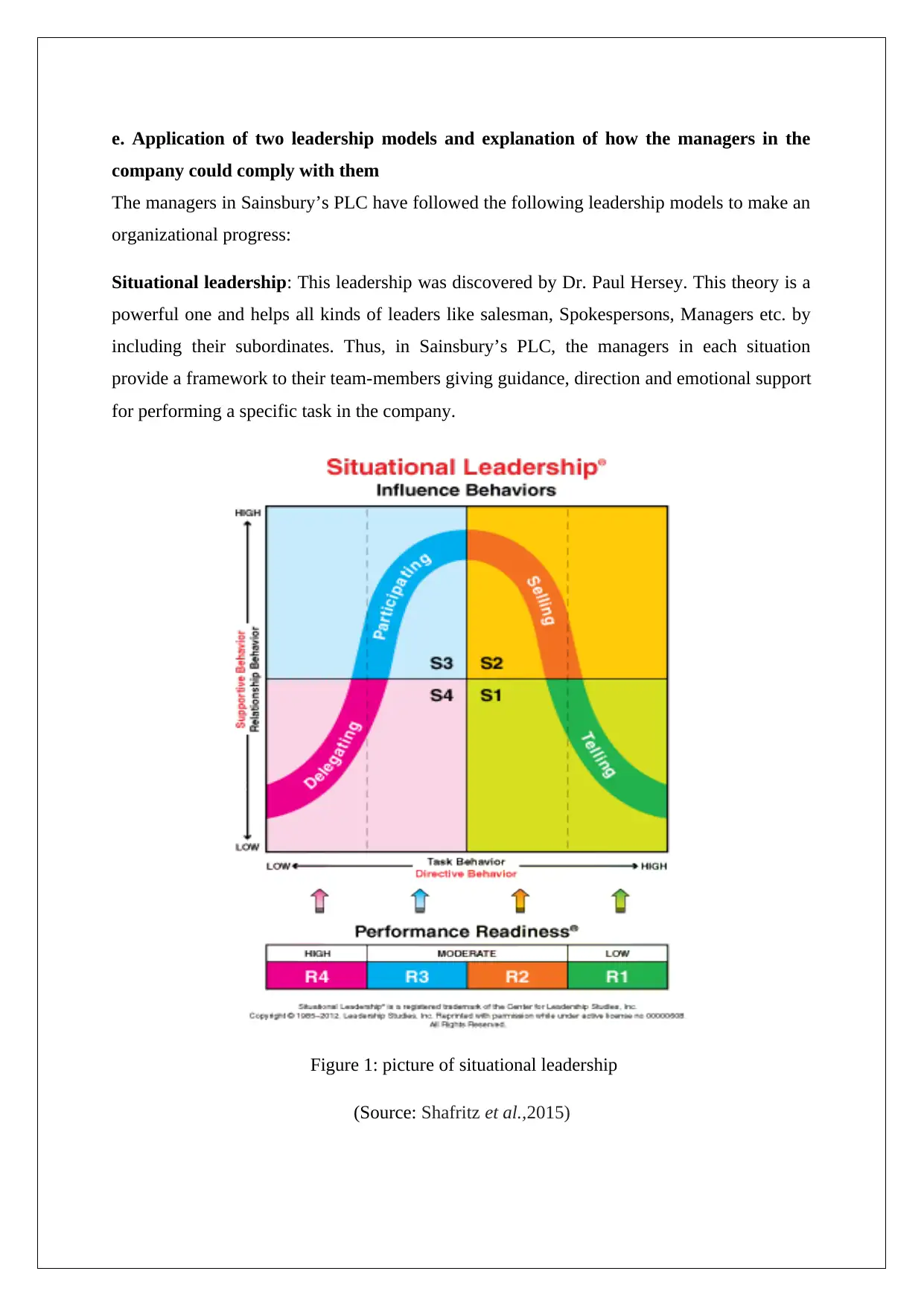
e. Application of two leadership models and explanation of how the managers in the
company could comply with them
The managers in Sainsbury’s PLC have followed the following leadership models to make an
organizational progress:
Situational leadership: This leadership was discovered by Dr. Paul Hersey. This theory is a
powerful one and helps all kinds of leaders like salesman, Spokespersons, Managers etc. by
including their subordinates. Thus, in Sainsbury’s PLC, the managers in each situation
provide a framework to their team-members giving guidance, direction and emotional support
for performing a specific task in the company.
Figure 1: picture of situational leadership
(Source: Shafritz et al.,2015)
company could comply with them
The managers in Sainsbury’s PLC have followed the following leadership models to make an
organizational progress:
Situational leadership: This leadership was discovered by Dr. Paul Hersey. This theory is a
powerful one and helps all kinds of leaders like salesman, Spokespersons, Managers etc. by
including their subordinates. Thus, in Sainsbury’s PLC, the managers in each situation
provide a framework to their team-members giving guidance, direction and emotional support
for performing a specific task in the company.
Figure 1: picture of situational leadership
(Source: Shafritz et al.,2015)
⊘ This is a preview!⊘
Do you want full access?
Subscribe today to unlock all pages.

Trusted by 1+ million students worldwide
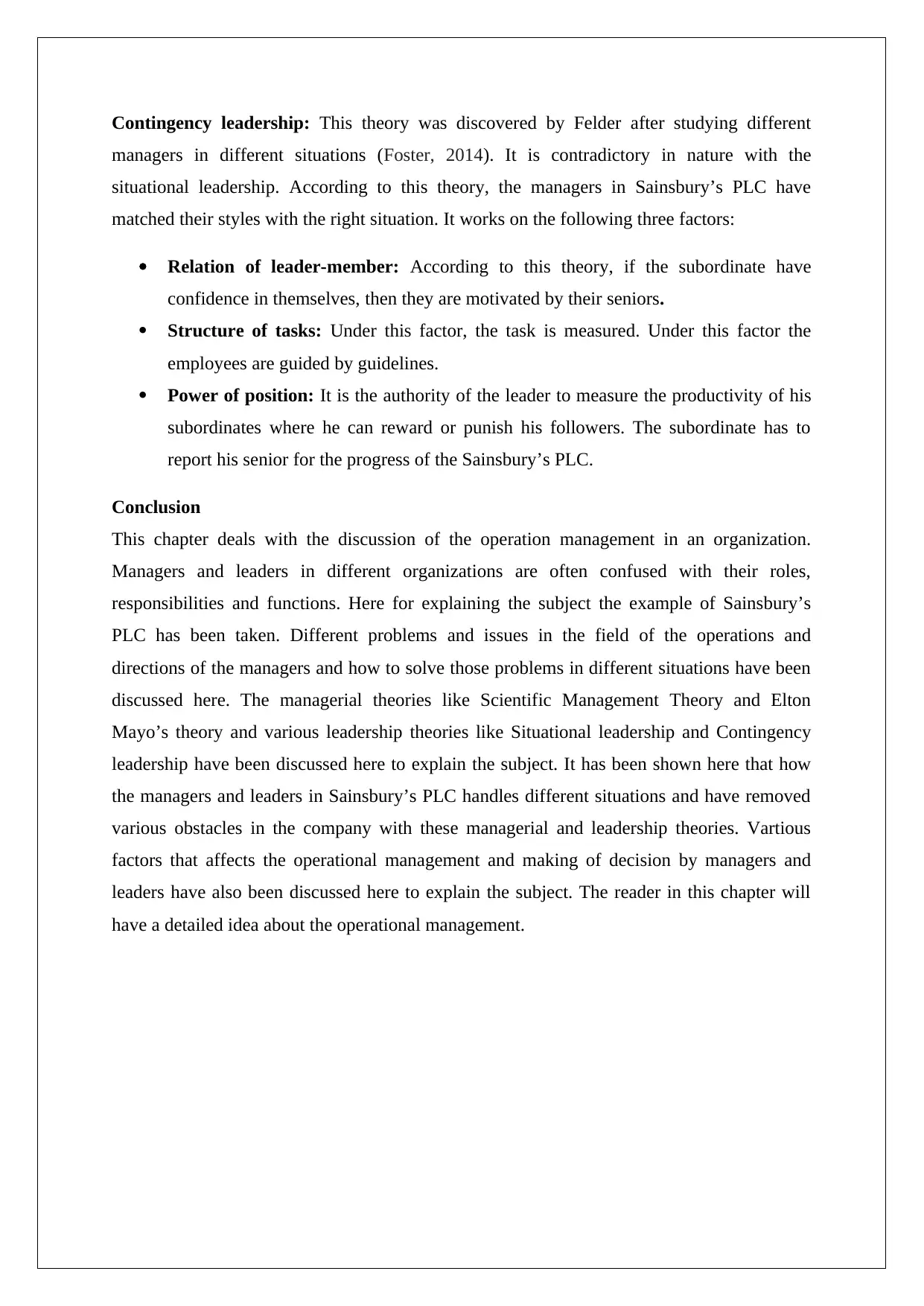
Contingency leadership: This theory was discovered by Felder after studying different
managers in different situations (Foster, 2014). It is contradictory in nature with the
situational leadership. According to this theory, the managers in Sainsbury’s PLC have
matched their styles with the right situation. It works on the following three factors:
Relation of leader-member: According to this theory, if the subordinate have
confidence in themselves, then they are motivated by their seniors.
Structure of tasks: Under this factor, the task is measured. Under this factor the
employees are guided by guidelines.
Power of position: It is the authority of the leader to measure the productivity of his
subordinates where he can reward or punish his followers. The subordinate has to
report his senior for the progress of the Sainsbury’s PLC.
Conclusion
This chapter deals with the discussion of the operation management in an organization.
Managers and leaders in different organizations are often confused with their roles,
responsibilities and functions. Here for explaining the subject the example of Sainsbury’s
PLC has been taken. Different problems and issues in the field of the operations and
directions of the managers and how to solve those problems in different situations have been
discussed here. The managerial theories like Scientific Management Theory and Elton
Mayo’s theory and various leadership theories like Situational leadership and Contingency
leadership have been discussed here to explain the subject. It has been shown here that how
the managers and leaders in Sainsbury’s PLC handles different situations and have removed
various obstacles in the company with these managerial and leadership theories. Vartious
factors that affects the operational management and making of decision by managers and
leaders have also been discussed here to explain the subject. The reader in this chapter will
have a detailed idea about the operational management.
managers in different situations (Foster, 2014). It is contradictory in nature with the
situational leadership. According to this theory, the managers in Sainsbury’s PLC have
matched their styles with the right situation. It works on the following three factors:
Relation of leader-member: According to this theory, if the subordinate have
confidence in themselves, then they are motivated by their seniors.
Structure of tasks: Under this factor, the task is measured. Under this factor the
employees are guided by guidelines.
Power of position: It is the authority of the leader to measure the productivity of his
subordinates where he can reward or punish his followers. The subordinate has to
report his senior for the progress of the Sainsbury’s PLC.
Conclusion
This chapter deals with the discussion of the operation management in an organization.
Managers and leaders in different organizations are often confused with their roles,
responsibilities and functions. Here for explaining the subject the example of Sainsbury’s
PLC has been taken. Different problems and issues in the field of the operations and
directions of the managers and how to solve those problems in different situations have been
discussed here. The managerial theories like Scientific Management Theory and Elton
Mayo’s theory and various leadership theories like Situational leadership and Contingency
leadership have been discussed here to explain the subject. It has been shown here that how
the managers and leaders in Sainsbury’s PLC handles different situations and have removed
various obstacles in the company with these managerial and leadership theories. Vartious
factors that affects the operational management and making of decision by managers and
leaders have also been discussed here to explain the subject. The reader in this chapter will
have a detailed idea about the operational management.
Paraphrase This Document
Need a fresh take? Get an instant paraphrase of this document with our AI Paraphraser
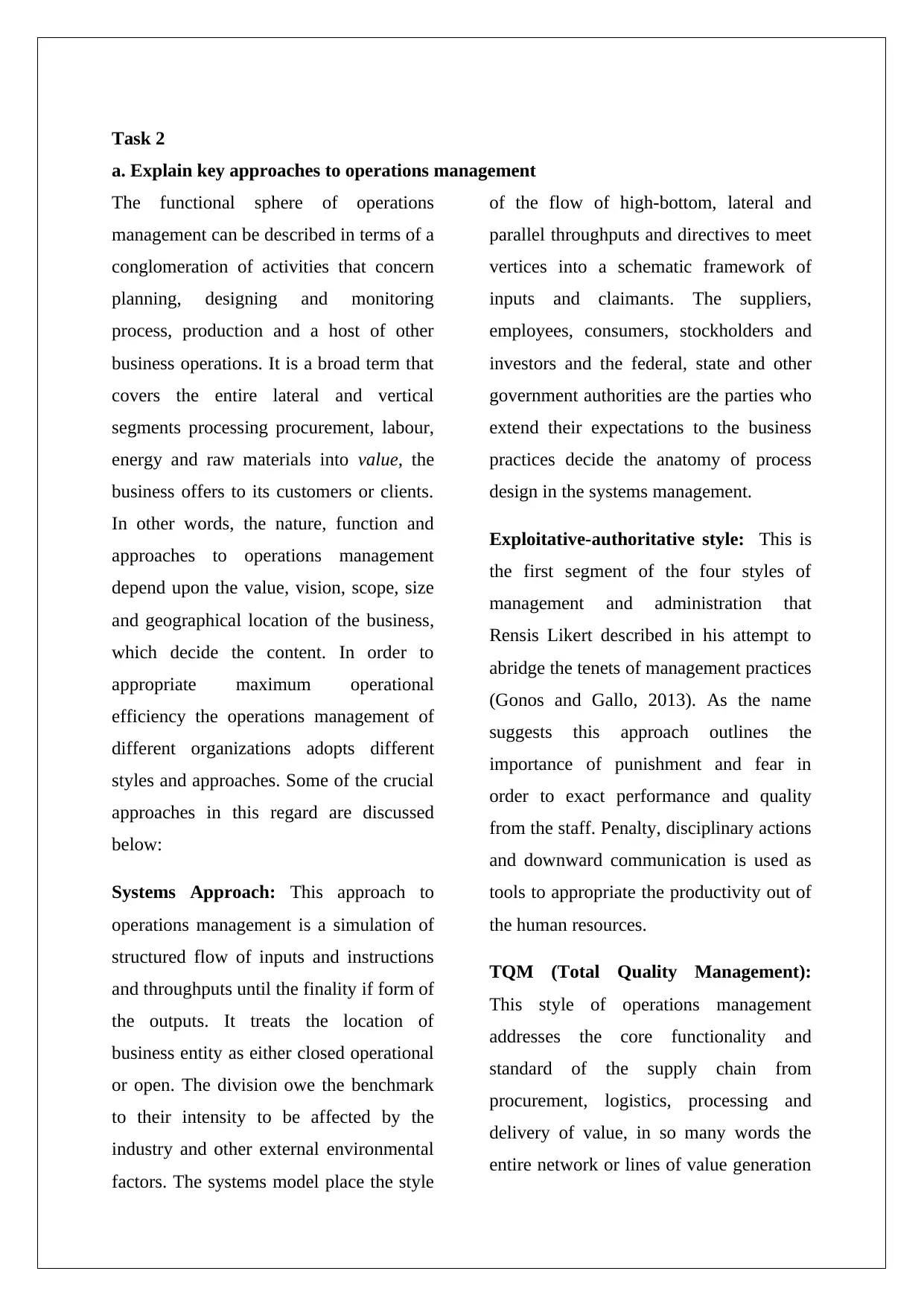
Task 2
a. Explain key approaches to operations management
The functional sphere of operations
management can be described in terms of a
conglomeration of activities that concern
planning, designing and monitoring
process, production and a host of other
business operations. It is a broad term that
covers the entire lateral and vertical
segments processing procurement, labour,
energy and raw materials into value, the
business offers to its customers or clients.
In other words, the nature, function and
approaches to operations management
depend upon the value, vision, scope, size
and geographical location of the business,
which decide the content. In order to
appropriate maximum operational
efficiency the operations management of
different organizations adopts different
styles and approaches. Some of the crucial
approaches in this regard are discussed
below:
Systems Approach: This approach to
operations management is a simulation of
structured flow of inputs and instructions
and throughputs until the finality if form of
the outputs. It treats the location of
business entity as either closed operational
or open. The division owe the benchmark
to their intensity to be affected by the
industry and other external environmental
factors. The systems model place the style
of the flow of high-bottom, lateral and
parallel throughputs and directives to meet
vertices into a schematic framework of
inputs and claimants. The suppliers,
employees, consumers, stockholders and
investors and the federal, state and other
government authorities are the parties who
extend their expectations to the business
practices decide the anatomy of process
design in the systems management.
Exploitative-authoritative style: This is
the first segment of the four styles of
management and administration that
Rensis Likert described in his attempt to
abridge the tenets of management practices
(Gonos and Gallo, 2013). As the name
suggests this approach outlines the
importance of punishment and fear in
order to exact performance and quality
from the staff. Penalty, disciplinary actions
and downward communication is used as
tools to appropriate the productivity out of
the human resources.
TQM (Total Quality Management):
This style of operations management
addresses the core functionality and
standard of the supply chain from
procurement, logistics, processing and
delivery of value, in so many words the
entire network or lines of value generation
a. Explain key approaches to operations management
The functional sphere of operations
management can be described in terms of a
conglomeration of activities that concern
planning, designing and monitoring
process, production and a host of other
business operations. It is a broad term that
covers the entire lateral and vertical
segments processing procurement, labour,
energy and raw materials into value, the
business offers to its customers or clients.
In other words, the nature, function and
approaches to operations management
depend upon the value, vision, scope, size
and geographical location of the business,
which decide the content. In order to
appropriate maximum operational
efficiency the operations management of
different organizations adopts different
styles and approaches. Some of the crucial
approaches in this regard are discussed
below:
Systems Approach: This approach to
operations management is a simulation of
structured flow of inputs and instructions
and throughputs until the finality if form of
the outputs. It treats the location of
business entity as either closed operational
or open. The division owe the benchmark
to their intensity to be affected by the
industry and other external environmental
factors. The systems model place the style
of the flow of high-bottom, lateral and
parallel throughputs and directives to meet
vertices into a schematic framework of
inputs and claimants. The suppliers,
employees, consumers, stockholders and
investors and the federal, state and other
government authorities are the parties who
extend their expectations to the business
practices decide the anatomy of process
design in the systems management.
Exploitative-authoritative style: This is
the first segment of the four styles of
management and administration that
Rensis Likert described in his attempt to
abridge the tenets of management practices
(Gonos and Gallo, 2013). As the name
suggests this approach outlines the
importance of punishment and fear in
order to exact performance and quality
from the staff. Penalty, disciplinary actions
and downward communication is used as
tools to appropriate the productivity out of
the human resources.
TQM (Total Quality Management):
This style of operations management
addresses the core functionality and
standard of the supply chain from
procurement, logistics, processing and
delivery of value, in so many words the
entire network or lines of value generation
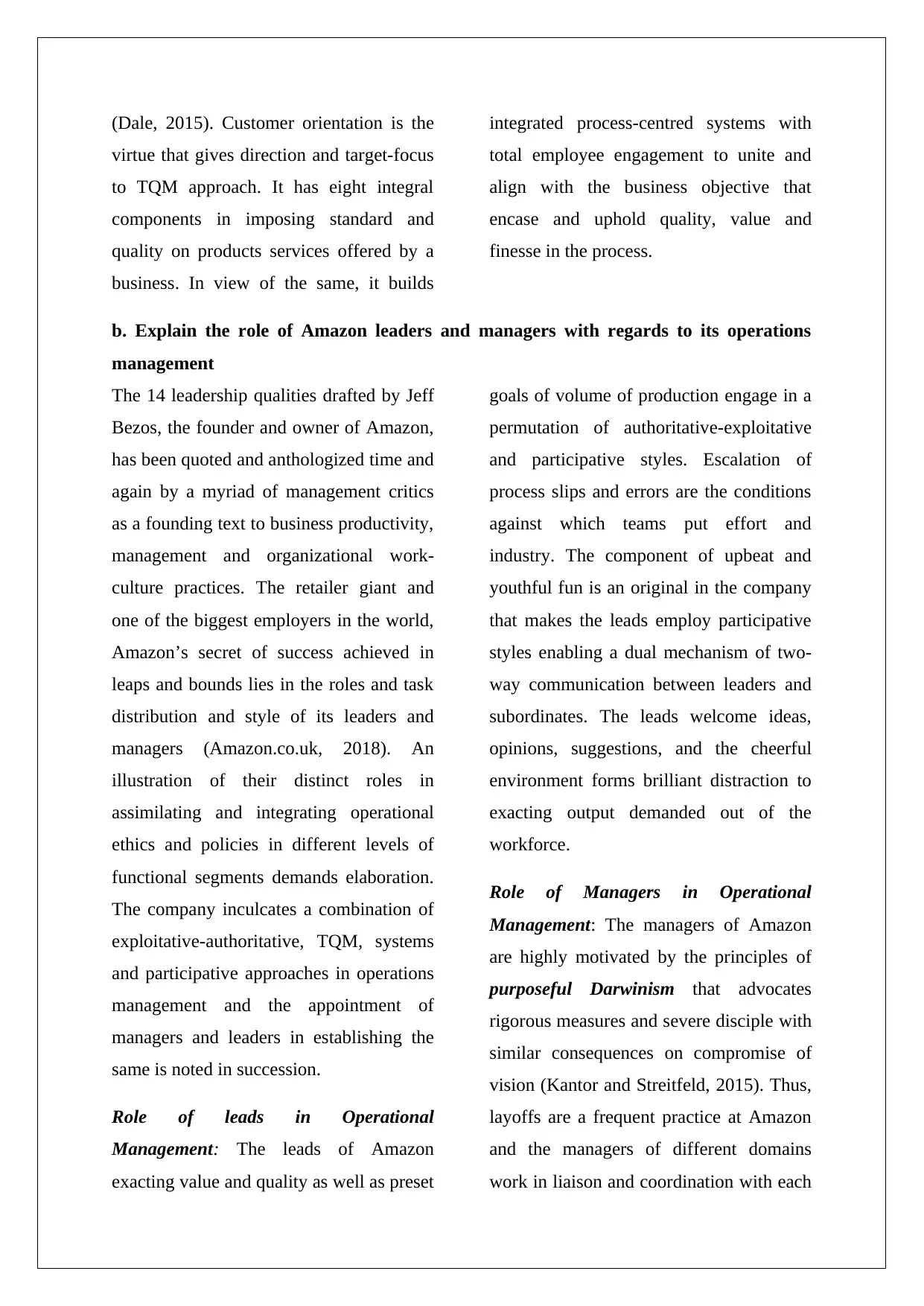
(Dale, 2015). Customer orientation is the
virtue that gives direction and target-focus
to TQM approach. It has eight integral
components in imposing standard and
quality on products services offered by a
business. In view of the same, it builds
integrated process-centred systems with
total employee engagement to unite and
align with the business objective that
encase and uphold quality, value and
finesse in the process.
b. Explain the role of Amazon leaders and managers with regards to its operations
management
The 14 leadership qualities drafted by Jeff
Bezos, the founder and owner of Amazon,
has been quoted and anthologized time and
again by a myriad of management critics
as a founding text to business productivity,
management and organizational work-
culture practices. The retailer giant and
one of the biggest employers in the world,
Amazon’s secret of success achieved in
leaps and bounds lies in the roles and task
distribution and style of its leaders and
managers (Amazon.co.uk, 2018). An
illustration of their distinct roles in
assimilating and integrating operational
ethics and policies in different levels of
functional segments demands elaboration.
The company inculcates a combination of
exploitative-authoritative, TQM, systems
and participative approaches in operations
management and the appointment of
managers and leaders in establishing the
same is noted in succession.
Role of leads in Operational
Management: The leads of Amazon
exacting value and quality as well as preset
goals of volume of production engage in a
permutation of authoritative-exploitative
and participative styles. Escalation of
process slips and errors are the conditions
against which teams put effort and
industry. The component of upbeat and
youthful fun is an original in the company
that makes the leads employ participative
styles enabling a dual mechanism of two-
way communication between leaders and
subordinates. The leads welcome ideas,
opinions, suggestions, and the cheerful
environment forms brilliant distraction to
exacting output demanded out of the
workforce.
Role of Managers in Operational
Management: The managers of Amazon
are highly motivated by the principles of
purposeful Darwinism that advocates
rigorous measures and severe disciple with
similar consequences on compromise of
vision (Kantor and Streitfeld, 2015). Thus,
layoffs are a frequent practice at Amazon
and the managers of different domains
work in liaison and coordination with each
virtue that gives direction and target-focus
to TQM approach. It has eight integral
components in imposing standard and
quality on products services offered by a
business. In view of the same, it builds
integrated process-centred systems with
total employee engagement to unite and
align with the business objective that
encase and uphold quality, value and
finesse in the process.
b. Explain the role of Amazon leaders and managers with regards to its operations
management
The 14 leadership qualities drafted by Jeff
Bezos, the founder and owner of Amazon,
has been quoted and anthologized time and
again by a myriad of management critics
as a founding text to business productivity,
management and organizational work-
culture practices. The retailer giant and
one of the biggest employers in the world,
Amazon’s secret of success achieved in
leaps and bounds lies in the roles and task
distribution and style of its leaders and
managers (Amazon.co.uk, 2018). An
illustration of their distinct roles in
assimilating and integrating operational
ethics and policies in different levels of
functional segments demands elaboration.
The company inculcates a combination of
exploitative-authoritative, TQM, systems
and participative approaches in operations
management and the appointment of
managers and leaders in establishing the
same is noted in succession.
Role of leads in Operational
Management: The leads of Amazon
exacting value and quality as well as preset
goals of volume of production engage in a
permutation of authoritative-exploitative
and participative styles. Escalation of
process slips and errors are the conditions
against which teams put effort and
industry. The component of upbeat and
youthful fun is an original in the company
that makes the leads employ participative
styles enabling a dual mechanism of two-
way communication between leaders and
subordinates. The leads welcome ideas,
opinions, suggestions, and the cheerful
environment forms brilliant distraction to
exacting output demanded out of the
workforce.
Role of Managers in Operational
Management: The managers of Amazon
are highly motivated by the principles of
purposeful Darwinism that advocates
rigorous measures and severe disciple with
similar consequences on compromise of
vision (Kantor and Streitfeld, 2015). Thus,
layoffs are a frequent practice at Amazon
and the managers of different domains
work in liaison and coordination with each
⊘ This is a preview!⊘
Do you want full access?
Subscribe today to unlock all pages.

Trusted by 1+ million students worldwide
1 out of 16
Related Documents
Your All-in-One AI-Powered Toolkit for Academic Success.
+13062052269
info@desklib.com
Available 24*7 on WhatsApp / Email
![[object Object]](/_next/static/media/star-bottom.7253800d.svg)
Unlock your academic potential
Copyright © 2020–2025 A2Z Services. All Rights Reserved. Developed and managed by ZUCOL.





